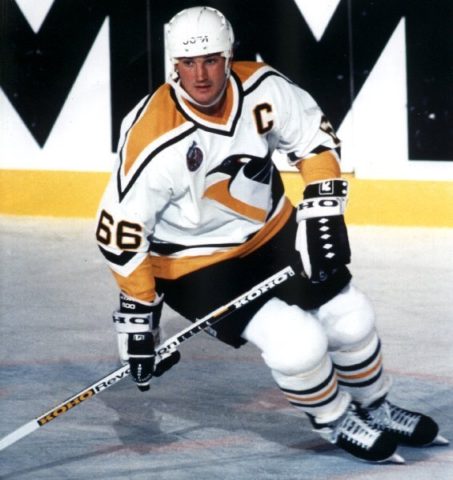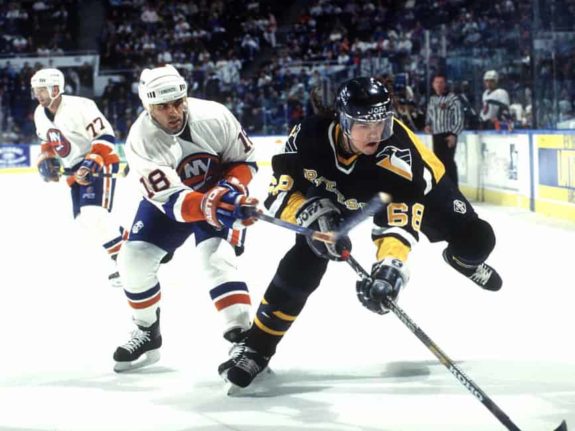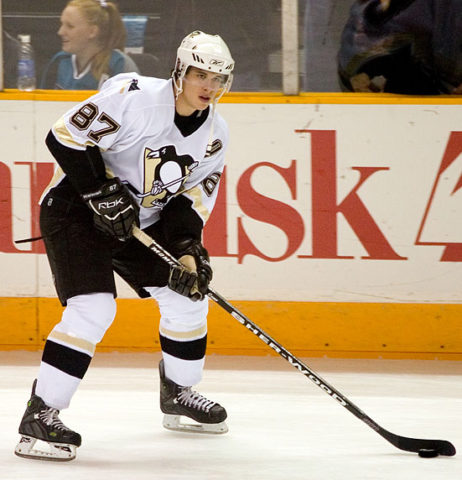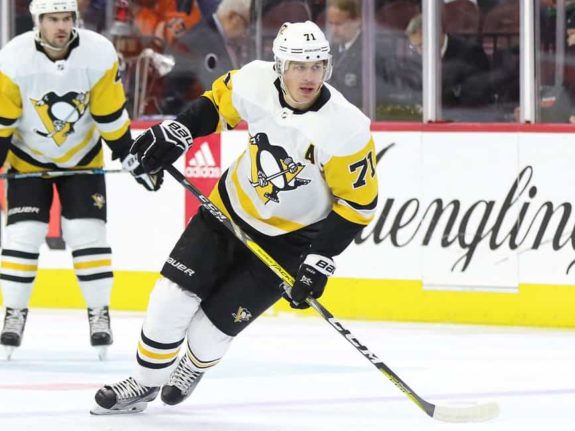The ’12 Days of Christmas’ is a classic holiday song first published in its current form in 1908. In a nod to the classic carol, join The Hockey Writers as we count down the 12 Days of Hockeymas. Each day, we will provide you with a piece of hockey history as we eagerly await the start of the 2020-21 NHL season.
On the seventh day, we’ll look back at the seven seasons in which a Penguins player captured the Hart Memorial Trophy, awarded to the league’s most valuable player.
1988 – Mario Lemieux
In the late 80s, the Penguins started to climb out of the basement of the league after drafting Lemieux in 1984 and surrounding him with quality players.

The decade, however, was dominated by Wayne Gretzky. The 1987-88 season marked the first time since 1979-80 that Gretzky did not own or share the lead in points as Lemieux piled up 168 points compared to Gretzky’s 149. Lemieux finished in the league lead with 70 goals, 14 ahead of teammate Craig Simpson.
It was also the only year of the decade that Gretzky did not win the Hart.
Lemieux credits a lot of his success during the 1987-88 campaign to the experience he gained during the 1987 Canada Cup. Playing with supertstars like Gretzky, Mark Messier, Raymond Bourque and Paul Coffey, Lemieux collected 11 goals in nine games — still a record.
The Canada Cup was very intense, but it was a great springboard for the NHL season. I was fortunate enough to win my first scoring title that season. The learning experience and the momentum of the Canada Cup were definitely factors in that.
Mario Lemieux via HHOF.com
The Penguins failed to make the playoffs by just one point during the 1987-88 season and Lemieux’s accolade remains the last time a player won the Hart on a team that missed the playoffs.
Ironically, Lemieux was much better statistically the next year with career-highs in points (199) and goals (85) while the Penguins made the playoffs.
1993 – Mario Lemieux
Heading into the 1992-93 season, the Penguins were coming off back-to-back Stanley Cup victories while being very much in the conversation to win another.
The Penguins had their best statistical year in franchise history, eventually claiming the President’s Trophy with a record of 56-21-7 (119 points). Pittsburgh had four players finish with 100-plus points and no one’s season was more incredible than that of Lemieux’s.
Pittsburgh started off the season 8-0-2 and seemingly never slowed down. Through 40 games, Lemieux already had 39 goals and 104 points. But, in January, Lemieux received the crushing news that he had been diagnosed with Hodgkin’s lymphoma and would have to step away from the game.
Lemieux was forced to sit out for four weeks while he underwent treatment and would amazingly return to the lineup on March 2 against the Philadelphia Flyers.
When he returned after the treatments, Lemieux was 17 points behind Pat LaFontaine in scoring and eventually won the scoring title by 12 points, despite playing 24 less games than LaFontaine.
1996 – Mario Lemieux
Lemieux’s final Hart Trophy came during the 1995-96 campaign after he missed the entire 1994-95 campaign due to injury.
Lemieux, along with Jaromir Jagr and Ron Francis, formed arguably the greatest line in Penguins’ history as they finished first, second and fourth in the league respectively in points.
In January, Lemieux reached the 100-point mark for the ninth time in his career. Lemieux scored three or more goals in a game six times during that season including a five-goal game against the St. Louis Blues in March.
The Penguins finished atop the Northeast Division with a record of 49-29-4 before losing in the conference finals to Florida.
1999 – Jaromir Jagr
In the late 90s, there was no better Penguin than Jagr. Sure, that notion is true in large part because Lemieux had retired after the 1996-97 season and would not return until 2001, but Jagr proved his worth with four-straight scoring titles from 1998 to 2001.

No season was better for Jagr than the 1998-99 campaign. He finished with a league-leading 127 points and 44 goals while leading Pittsburgh to a 38-30-14 record, good enough for third place in the Atlantic Division and a playoff berth.
Jagr compiled 37 points through the first 20 games and 70 through 39 games. The Penguins slipped into the playoffs as an eight seed before upsetting the top-seeded New Jersey Devils in seven games. Pittsburgh lost in six games to the Toronto Maple Leafs in the following round.
2007 – Sidney Crosby
As the Penguins transitioned from their Lemieux-era in the early 2000s, there was not a better candidate to become the face of the franchise than Crosby. Sid the Kid opened eyes right from the very start and gave Penguins fans hope that the franchise was in good hands.
After amazingly collecting 39 goals and 102 points in his rookie season and finishing second in Calder Memorial Trophy voting, Crosby had bigger aspirations on his horizon the following season.
The next season, Crosby solidified himself as a superstar in the league — as if it hadn’t already been. Crosby scored his first hat trick in late October and picked up momentum.

By December, he notched his first six-point game with a goal and five assists against Philadelphia. The six-point game put him into the scoring lead and he would not give up the lead.
Crosby finished with 36 goals, 84 assists and 120 points in 79 games, becoming the first teenager to lead the league in points since Gretzky completed the feat in 1980.
Sid the Kid became the youngest player in NHL history to win the Art Ross while also becoming the youngest scoring champion in any major North American sport.
2012 – Evgeni Malkin
While Crosby was winning the Hart Trophy in his second season, Malkin made his presence known capturing the Calder Trophy and getting a taste for stardom.
A few years later, Malkin was at the top of his game just six months after major reconstructive knee surgery.

Malkin, on a team that was missing Crosby who was trying to recover from post-concussion issues, managed to collect 50 goals and 109 points while leading the league in multiple offensive categories.
‘Geno’ led the league in points (109), shots on goal (339) while finishing second in goals (50), fourth in game-winning goals (nine) and eighth in power-play goals (12).
It was Malkin’s first Hart in three nominations as the Penguins finished the season with a record of 51-25-6 before falling to the Philadelphia Flyers in six games in the first round.
2014 – Sidney Crosby
Crosby saw some of the toughest years of his career through 2010-2012 as the captain dealt with post-concussion issues. But, Crosby’s mental toughness prevailed in the years that followed.
During the 2013-14 campaign, Crosby played 80 games for the first time since the 2009-10 season and thrived offensively. Crosby led the league in assists for the first time in his career with 68 while finishing with a league-leading 104 points (16 more than any other player.)
Crosby finished with 128 first-place votes as runner-up Ryan Getzlaf collected five. He notched 30 multi-point games and never went more than two consecutive games without registering a point.
Sid the Kid also reached the 700-goal plateau during the season becoming the fastest among active players to do so and sixth-fastest in league history.
The Penguins rank second among non-Original Six teams for most Hart Trophy-winning seasons and are tied for fifth overall. As Crosby and Malkin enter their age 33 and 34 seasons respectively, the two superstars are sure to be on the hunt for Pittsburgh’s eighth Hart Trophy season.
Stay tuned to The Hockey Writers as the 12 Days of Hockeymas continues with the Penguins’ six Prince of Wales trophies.